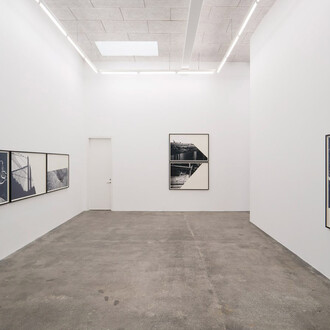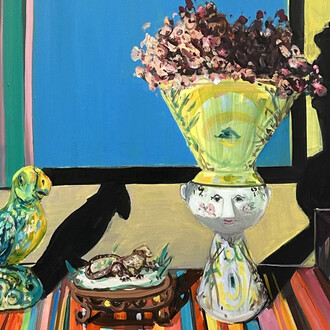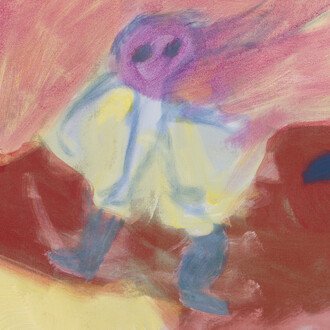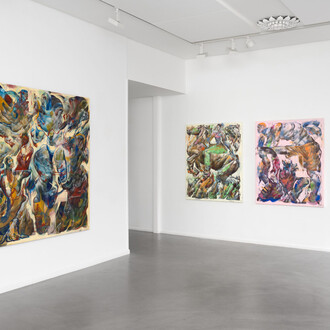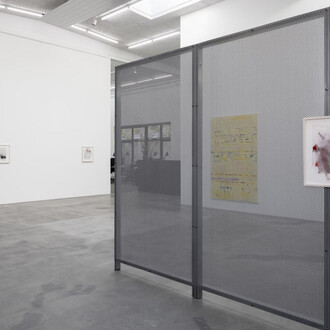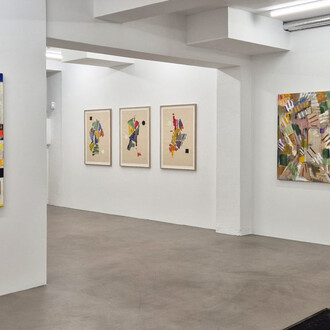Rendered in deep black bronze, The pregnant Madonna by Alexander Tovborg presents a reclining Madonna figure, pregnant and radiant, her belly becoming the focal point – both a literal and symbolic center. The form evokes celestial imagery, as if the womb itself were a planet, glowing with the promise of life and the mystery of origins. In this powerful gesture, Tovborg links the sacred and the universal, the maternal and the cosmic, positioning the body not just as vessel, but as universe.
Alexander Tovborg is one of the most acclaimed artists working in Denmark today. Across sculpture, painting, drawing and installation, his practice is rooted in an ongoing exploration of mythology, spirituality, and shared cultural narratives. With a richly symbolic visual language, Tovborg constructs layered works that draw on religious iconography and ancient storytelling to probe contemporary issues – from human desire and belief to our need for connection, meaning, and mercy. Always insistent on our shared humanity, his work offers both reflection and reckoning.
Kinga Bartis (b. 1984, Transylvania) is widely recognized for their evocative and emotive paintings that explore themes of identity, longing, love, mourning and more. Their work is rooted in philosophical and psychological frameworks that question how we perceive, understand, and navigate our sense of self and the world around us.
Bartis envisions painting as a means of breaking free from the habitual ways of defining our being—instead they look towards a multidisciplinary, open approach. Bartis’ work is characterized by their distinctive use of colour and texture, often blending figurative elements with abstract forms. The paintings evoke a sense of mystery and psychological depth in which they employ a muted, sometimes haunting palette, thus creating works that are introspective and reflective. Their ability to create narrative through nuanced brushstrokes and exploration of the complexities of our conceptions of ourselves and various realities have earned them critical acclaim. Breaking with conventions, as stars in the background, plants on the ground—normally used to signify position and space—are deliberately scattered. Here, Bartis invites us to abandon our traditional ways of interpreting painting and instead shift our focus to the scapes that they create.
Jose Dávila (b. 1974, Mexico) is one of today’s most influential Mexican artists working internationally. Dávila draws on his training as an architect and his knowledge of art history to create sculptural installations, photographic works and paintings that simultaneously emulate, critique, and pay homage to 20th-century avant-garde art and architecture. Throughout his artistic career, Dávila’s practice has explored spatial occupation and the transitory nature of physical structures.
In his sculptures, Dávila employs industrial and quotidian materials to make simultaneously humorous and critical reference to Modernist masterpieces. In these works, materials are held in semiotic and structural tension – balanced both between high and low culture, and between permanence and collapse. Employing gravity and chance as materials, Dávila’s carefully arranged, and precariously balanced works expand the conventions of historical forms, and test the limits of the medium of sculpture.
Elmgreen & Dragset (collaborating since 1995) explore the blurred line that divides our public and private personas by investigating how we shift, perform and build our identities depending on the context. The duo cleverly unpack intimate subjects such as gender, sexuality, relationships, the balance of power and sociopolitical structures. Themes of powerlessness and interrupted functions have spanned their career, with clocks whose arms cannot move, doors that cannot open, stairs that have fallen apart, diving boards that are inverted and pools that have been emptied.
A long, low plinth is situated on the floor, its black polished surface slightly reflects the surroundings. Upon the plinth at opposing ends are two white-painted bronze slugs, casts of the humble creature often found in common gardens, seemingly crossing the plinth, slowly, towards each other. Although static in their positions, each sculpted creature has an implied journey, emanating a sense of transition and slow, directional movement. Why are they moving towards each other? Would their paths eventually cross as suggested in the artwork title, This is how we re-inite, or would one slug potentially veer off the plinth entirely if it were living and breathing? Numerous questions and possible narratives might arise upon encountering this work. Yet, thereafter, This is how we re-inite entices further reflection on the broader nature of sculpture itself. Subverting traditional modes of viewing art and recalling the radical separation of artwork and plinth explored in Minimalism through the 1960s and 70s, the work compels its viewers to look down upon the sculpture, to physically encounter the artwork in an atypical way, further adding to a sense of the enigmatic. The play with scale blurs the hierarchy between plinth and object—the largeness of the glossy black surface sits juxtaposition with the two small matt-white slugs.





